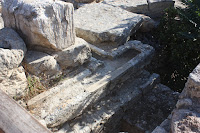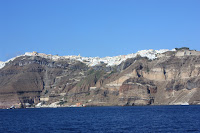Palace of Knossos
 The Palace of Knossos - pronounced kuh-noh SOS - is a massive, multi-leveled structure that was the cultural center of Minoan life. It is mentioned in Homer's Odyssey. The earliest parts of the palace were built sometime around 1900 BC. The site was discovered in 1878. Excavations began in AD 1900 under the supervision of English archaeologist
Sir Arthur Evans and his team, and they continued for 35
years. Evans made thousands of amazing discovries here and supervised the reconstruction of whole sections of the palace for the benifit of visitors. According to our gide, not everyone in modern archeology is happy with Evans and his methods. His desire was that people would be able to see this palace in its glory through reconstrction. Many would like him to have not tried to reconstruct, fearing that accuracty was lost in the process.
The Palace of Knossos - pronounced kuh-noh SOS - is a massive, multi-leveled structure that was the cultural center of Minoan life. It is mentioned in Homer's Odyssey. The earliest parts of the palace were built sometime around 1900 BC. The site was discovered in 1878. Excavations began in AD 1900 under the supervision of English archaeologist
Sir Arthur Evans and his team, and they continued for 35
years. Evans made thousands of amazing discovries here and supervised the reconstruction of whole sections of the palace for the benifit of visitors. According to our gide, not everyone in modern archeology is happy with Evans and his methods. His desire was that people would be able to see this palace in its glory through reconstrction. Many would like him to have not tried to reconstruct, fearing that accuracty was lost in the process.
 I am not an archaeology expert in any sense, but I am sympathetic with those who are disappointed by the reconstructions on the site. They are spectacular, but I think I would prefer seeing the actual, original ruins with artist renderings or models set up in the same vicinity. None the less, to simply say this site is impressive would be an understatement.
I am not an archaeology expert in any sense, but I am sympathetic with those who are disappointed by the reconstructions on the site. They are spectacular, but I think I would prefer seeing the actual, original ruins with artist renderings or models set up in the same vicinity. None the less, to simply say this site is impressive would be an understatement. |
| Our guide describing one of the reconstructed frescoes |
 The palace had at least 6 different levels with a massive staircase weaving up and down like a labyrinth. It also had both hot and cold running water and toilets in the royal quarters, equipped with continually running water. This is still an active archaeological site today. There has been evidence of civilization here dating back as far as the 8th century BC.
The palace had at least 6 different levels with a massive staircase weaving up and down like a labyrinth. It also had both hot and cold running water and toilets in the royal quarters, equipped with continually running water. This is still an active archaeological site today. There has been evidence of civilization here dating back as far as the 8th century BC. |
| Part of the water system running throughout the palace |
 |
| reconstructed part of the ancient staircase |
Santorini
 |
| Looking up at the cities atop caldera from sea level |
The view from atop the caldera back toward our ship
The City of Oia (EE-ah), which we visited, has a population of about 1,000 and 70 of these beautiful churches/chapels. From what we saw it probably also has about half as many dogs and cats as people.

 This was our last full day of the cruise. Tomorrow we head back to Athens where we will meet Alex and Eleni Melirrytou. They will lead us on a tour of ancient Corinth! These are good days!
This was our last full day of the cruise. Tomorrow we head back to Athens where we will meet Alex and Eleni Melirrytou. They will lead us on a tour of ancient Corinth! These are good days!





No comments:
Post a Comment